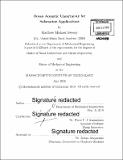| dc.contributor.advisor | Pierre F. J. Lermusiaux. | en_US |
| dc.contributor.author | Swezey, Matthew Michael | en_US |
| dc.contributor.other | Massachusetts Institute of Technology. Department of Mechanical Engineering. | en_US |
| dc.date.accessioned | 2016-09-13T19:20:08Z | |
| dc.date.available | 2016-09-13T19:20:08Z | |
| dc.date.copyright | 2016 | en_US |
| dc.date.issued | 2016 | en_US |
| dc.identifier.uri | http://hdl.handle.net/1721.1/104274 | |
| dc.description | Thesis: S.M. in Naval Architecture and Marine Engineering, Massachusetts Institute of Technology, Department of Mechanical Engineering, 2016. | en_US |
| dc.description | Thesis: S.M. in Mechanical Engineering, Massachusetts Institute of Technology, Department of Mechanical Engineering, 2016. | en_US |
| dc.description | Cataloged from PDF version of thesis. | en_US |
| dc.description | Includes bibliographical references (pages 119-125). | en_US |
| dc.description.abstract | The focus of this research is to study the uncertainties forecast by multi-resolution ocean models and quantify how those uncertainties affect the pressure fields estimated by coupled ocean models. The quantified uncertainty can then be used to provide enhanced sonar performance predictions for tactical decision aides. High fidelity robust modeling of the oceans can resolve various scale processes from tidal shifts to mesoscale phenomena. These ocean models can be coupled with acoustic models that account for variations in the ocean environment and complex bathymetry to yield accurate acoustic field representations that are both range and time independent. Utilizing the MIT Multidisciplinary Environmental Assimilation System (MSEAS) implicit two-way nested primitive-equation ocean model and Error Subspace Statistical Estimation scheme (ESSE), coupled with three-dimensional-in-space (3D) parabolic equation acoustic models, we conduct a study to understand and determine the effects of ocean state uncertainty on the acoustic transmission loss. The region of study is focused on the ocean waters surrounding Taiwan in the East China Sea. This region contains complex ocean dynamics and topography along the critical shelf-break region where the ocean acoustic interaction is driven by several uncertainties. The resulting ocean acoustic uncertainty is modeled and analyzed to quantify sonar performance and uncertainty characteristics with respect to submarine counter detection. Utilizing cluster based data analysis techniques, the relationship between the resulting acoustic field and the uncertainty in the ocean model can be characterized. Furthermore, the dynamic transitioning between the clustered acoustic states can be modeled as Markov processes. This analysis can be used to enhance not only submarine counter detection aides, but it may also be used for several applications to enhance understanding of the capabilities and behavior of uncertainties of acoustic systems operating in the complex ocean environment. | en_US |
| dc.description.statementofresponsibility | by Matthew Michael Swezey. | en_US |
| dc.format.extent | 125 pages | en_US |
| dc.language.iso | eng | en_US |
| dc.publisher | Massachusetts Institute of Technology | en_US |
| dc.rights | M.I.T. theses are protected by copyright. They may be viewed from this source for any purpose, but reproduction or distribution in any format is prohibited without written permission. See provided URL for inquiries about permission. | en_US |
| dc.rights.uri | http://dspace.mit.edu/handle/1721.1/7582 | en_US |
| dc.subject | Mechanical Engineering. | en_US |
| dc.title | Ocean acoustic uncertainty for submarine applications | en_US |
| dc.type | Thesis | en_US |
| dc.description.degree | S.M. in Naval Architecture and Marine Engineering | en_US |
| dc.description.degree | S.M. in Mechanical Engineering | en_US |
| dc.contributor.department | Massachusetts Institute of Technology. Department of Mechanical Engineering | |
| dc.identifier.oclc | 958161300 | en_US |
